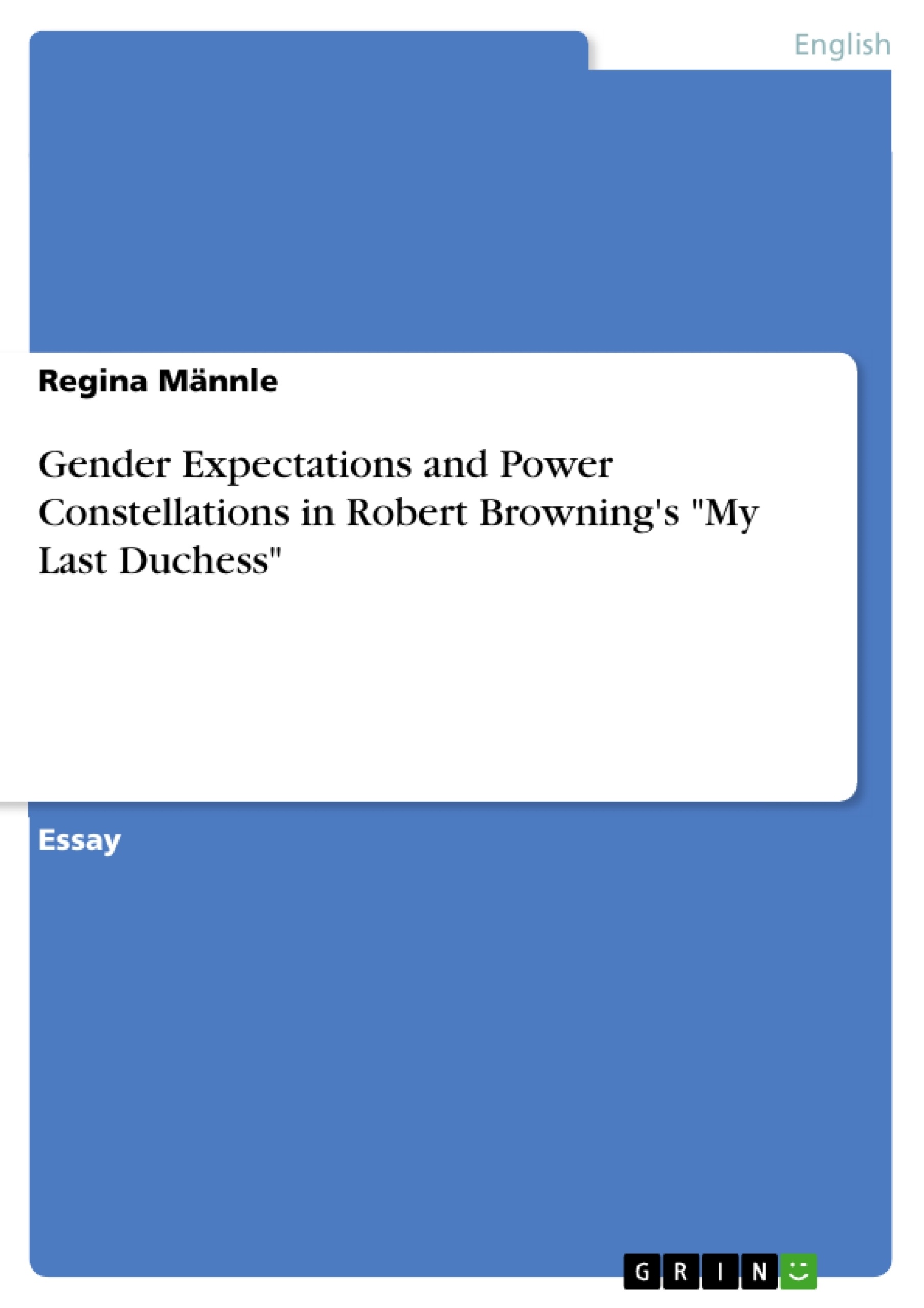The situation does not seem to be particularly exciting at all: A wealthy and civilised Renaissance duke chatting harmlessly with the envoy of a count whose daughter he is planning to marry. Before the two men start to discuss the financial details of the marriage, the duke tries to show his best side and presents himself as an art-loving and generous nobleman. But the story takes a chilling turn: While the host and his guest look at the portrait of the last duchess, the duke makes some remarks that suggest he may have murdered his wife.
On the surface, "My Last Duchess" seems to be a startling and entertaining mystery story, but considering the society and the environment that shaped the author, one cannot shake off the feeling that this poem is more than a story about a long-deceased Renaissance nobleman and his recalcitrant and disobedient wife. The poem touches some issues that were prevailing in the Victorian era and were of high interest to Browning's contemporaries: morality, gender expectations and power relations.
Table of Contents
- Gender Expectations and Power Constellations in Robert Browning's "My Last Duchess"
Objectives and Key Themes
The main objective of this analysis is to explore the complexities of gender expectations and power dynamics within Robert Browning's poem, "My Last Duchess." It examines how the poem reflects Victorian societal norms and attitudes toward women.
- Gender Roles and Expectations in the Victorian Era
- Power Dynamics and Control within Marriage
- The Duke's Psychological Profile and Obsession with Control
- The Use of Dramatic Monologue as a Literary Device
- Social Commentary on Victorian Morality and Gender Ideals
Chapter Summaries
Gender Expectations and Power Constellations in Robert Browning's "My Last Duchess": This analysis delves into Robert Browning's "My Last Duchess," exploring its intricate depiction of gender roles and power imbalances within a Victorian context. The poem, framed as a dramatic monologue, unveils the chilling narrative of a Renaissance Duke who implicitly reveals the murder of his wife. Through a close reading of the Duke's words, we see how his seemingly harmless conversation with an envoy subtly exposes his controlling nature and his disregard for his late wife's autonomy. The Duke's possessive attitude toward his "last duchess," his control over the narrative and the artwork depicting her, all serve to highlight the patriarchal power structures and the constrained role of women during this period. The poem uses formal elements, such as the dramatic monologue and heroic couplets, to create an initial sense of order and control that is gradually undermined by the Duke's unsettling revelations. The analysis explores the Duke's psychological profile, examining his justification of his actions and exploring his use of language to manipulate and control the situation. It also analyzes the poem's broader social commentary, highlighting how it critiques the Victorian notion of "domestic ideology" and its stifling impact on women.
Keywords
Robert Browning, My Last Duchess, Victorian Era, Gender Roles, Power Dynamics, Dramatic Monologue, Patriarchy, Domestic Ideology, Social Commentary, Control, Possession.
Robert Browning's "My Last Duchess": A Comprehensive Analysis - FAQ
What is the main objective of this analysis of Robert Browning's "My Last Duchess"?
The primary goal is to examine the intricate interplay of gender expectations and power dynamics within the poem. It investigates how the poem reflects Victorian societal norms and attitudes toward women.
What are the key themes explored in the analysis?
The analysis focuses on several key themes: gender roles and expectations in the Victorian era; power dynamics and control within marriage; the Duke's psychological profile and obsession with control; the use of dramatic monologue as a literary device; and social commentary on Victorian morality and gender ideals.
What does the analysis reveal about the Duke's character in "My Last Duchess"?
The analysis delves into the Duke's controlling nature and his disregard for his late wife's autonomy. His possessive attitude and manipulation of language are highlighted, revealing a chilling psychological profile and justification of his actions.
How does the poem use literary devices to convey its themes?
The analysis emphasizes the poem's use of the dramatic monologue and heroic couplets. It discusses how these formal elements initially establish a sense of order and control, which is later undermined by the Duke's unsettling revelations.
What is the poem's social commentary?
The analysis explores the poem's critique of Victorian "domestic ideology" and its stifling impact on women. It highlights how the poem reveals the patriarchal power structures and the constrained role of women during the Victorian era.
What are the key aspects of the Victorian context explored in this analysis?
The analysis considers Victorian gender roles, expectations, and power imbalances within marriage as crucial factors in understanding the poem's meaning and impact.
What is included in this language preview?
This preview provides a comprehensive overview, including the title, table of contents, objectives and key themes, chapter summaries, and keywords.
What is the overall focus of the chapter summary provided?
The chapter summary provides a detailed breakdown of the analysis of "My Last Duchess," focusing on the exploration of gender roles, power imbalances, the Duke's character, the use of literary devices, and the poem's social commentary within a Victorian context.
What are the keywords associated with this analysis?
Key words include: Robert Browning, My Last Duchess, Victorian Era, Gender Roles, Power Dynamics, Dramatic Monologue, Patriarchy, Domestic Ideology, Social Commentary, Control, Possession.
- Quote paper
- Dipl.-Bibl. Regina Männle (Author), 2006, Gender Expectations and Power Constellations in Robert Browning's "My Last Duchess", Munich, GRIN Verlag, https://www.grin.com/document/129000




